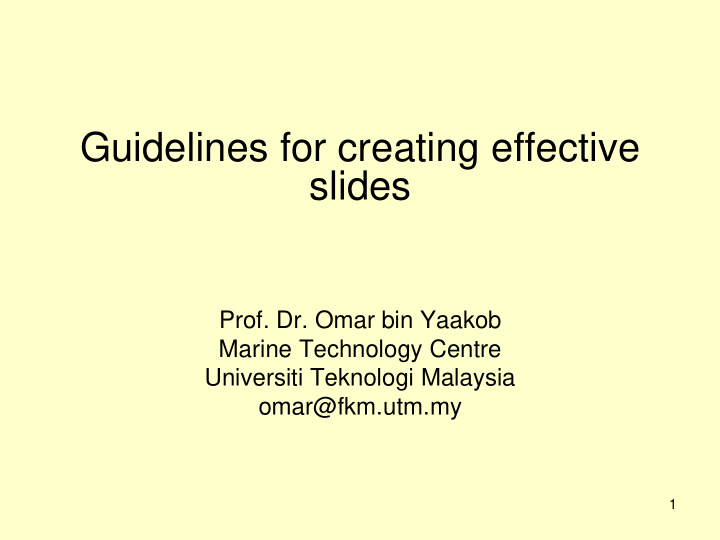



Guidelines for creating effective slides Prof. Dr. Omar bin Yaakob Marine Technology Centre Universiti Teknologi Malaysia omar@fkm.utm.my 1
The Slides should.. • Enhance Understanding • Guide Audience • Support Claims/Show Evidence Used Poorly…A Distraction…Ineffective Presentation 2
Guiding Principles • Make it simple. • Make it clear. • Don’t let the technology dominate the presentation. You want the audience to remember the quality of your research, not your beautiful PowerPoint. 3
Get Organised • What will you cover, what can be eliminated? • How much detail do you need? • Remember, your time and your audience’s attention are limited. For any part of your presentation, ask yourself “Is this slide very important?”, “ Do I need to put this in?”, “How does it relate to the previous and next slide?”, “Why should this be put here and not there?” 4
Transitions, animations and hyperlinks • Do not use slide transition • Use animation only when necessary to emphasis a point. • There is no need to ‘ selak sikit sikit ’ i.e. line by line animation. • Do not use hyperlinks except very necessary 5
Make sure slides are readable Remember Contrast & Font Size • When making slides, use a light background and dark letters, or light text on a dark background. • Use a big enough font. Use 20-32 points. 6
Format for Scientific Presentations • Stick to plain/simple backgrounds. Fancy formatsare more appropriate for business or kindergartenpresentations. • Avoid cute clip arts 7
General Format Rules • Stick to a maximum of two READABLE typefaces. • Do not use fancy fonts like Comic sans or Lucida • Limit the use of color. • Pick a style and stick with it. • Keep it short, especially titles. • Leave empty space. 8
General Format Rules (cont) • Be brief, straight to the point • Don’t include every word you will say. • Limit to one idea per slide. • Rule of six! Preferably, No more than six words per line and six lines per slide. 9
Presenting Data • Make data/results the focus of your presentation. • Don’t try to include all data— if necessary use handouts for detailed information or refer audience to a Web site. • Use color or special effects sparingly and consistently. 10
When Presenting Graphs or Tables 1. Where it comes from. 2. What is it about, describe briefly the curves or data, explain the collumn and rows or x and y axes and legend 3. What are the main/significant/relevant finding/information/results/data/trend. 4. What next? Or so what? i.e. what do you want to do with the main/significant/ relevant finding/information/results/ data/trend? Give time for your audience to absorb 11
Do not loose the plot • Thesis/research presentation is telling a story, there is a plot, scheme, big picture. (Same as written thesis) • Make sure there is connection between one slide and the next. • Use signposts along the way. 12
Final Steps • Practice! Recruit a friendly and constructively critical audience. • Recruit a grammar expert. • Show your presentation to someone who knows nothing about your field. Do they get what you want to say? 13
Logistics • How big is the hall where you will be speaking? • How much time will you be given? • What time of day is your talk? • This will determine your slides numbers, font size, colours, etc. 14
Equipment Needs • Ask what you will be given and what you must bring with you. • Consider all equipment you will need — • Internet connection • Computer (can you use your computer? Can their computer run your video? • Microphone • Software • Pointer 15
Disaster Planning • Consider what could go wrong and plan accordingly. • Always have a backup (thumbdrive,email your presentation to yourself, use Dropbox, Gdrive) • Arrive early, load and test. Remember some computers may not be able to play your Powerpoint or video versions. 16
Remember! • Keep it simple. • Don’t let the technology dominate your message. • Rule of six. • Cover your important points. 17
Thank You 18
Recommend
More recommend